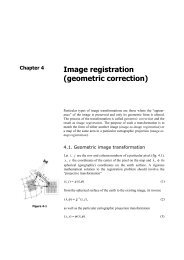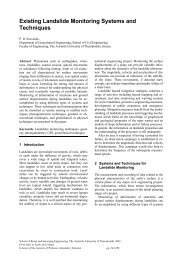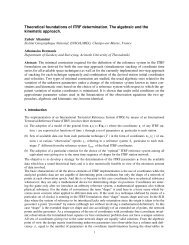s - Athanasios Dermanis Home Page
s - Athanasios Dermanis Home Page
s - Athanasios Dermanis Home Page
You also want an ePaper? Increase the reach of your titles
YUMPU automatically turns print PDFs into web optimized ePapers that Google loves.
erty of unbiased prediction is<br />
β = E { sˆ<br />
′− s′<br />
} = E{<br />
ε}<br />
= 0 . (4)<br />
Since s′ ˆ is quadratic in y , ε<br />
2<br />
will be of the 4th order in<br />
y , and consequently φ will depend on up to 4th order<br />
(central) moments of s , v , and cross-moments of s′ and<br />
s . To describe these moments in matrix notation we introduce<br />
the following basic definitions :<br />
m= E{s} , δ s=<br />
s−m<br />
, δ y = y −m=<br />
δs+<br />
v (5)<br />
m ′ = E{s′<br />
} , δ s ′= s′−m′<br />
(6)<br />
C s<br />
= E{ δsδsT<br />
} , C E{ vvT<br />
v = }, (7)<br />
C = E{ δ yδy<br />
T<br />
}= C s + C v , (8)<br />
δ ′ ′ , (9)<br />
c<br />
T<br />
s s ′ = E{ sδs<br />
} = E{<br />
δyδs<br />
} = c s ′ s<br />
σ<br />
2<br />
= E{( s )<br />
2}<br />
, (10)<br />
′<br />
s ′<br />
δ<br />
⎡-1<br />
⎤<br />
- = E y y y<br />
⎢ ⎥<br />
{ vec(<br />
δ δ<br />
T<br />
) δ<br />
T<br />
} = = - s + -<br />
⎢<br />
<br />
⎥<br />
v , (11)<br />
⎢⎣<br />
- ⎥<br />
n ⎦<br />
- E{ s y y<br />
T<br />
} E{<br />
s s sT<br />
′ s = δ ′ δ δ = δ ′ δ δ } , (12)<br />
<br />
s<br />
= E{ vec(<br />
δyδy<br />
T<br />
) vec T ( δyδy<br />
T<br />
)}=<br />
⎡<br />
=<br />
⎢<br />
⎢<br />
⎢⎣<br />
3. Solution<br />
11<br />
<br />
n1<br />
<br />
<br />
<br />
1n<br />
<br />
nn<br />
⎤<br />
⎥<br />
⎥<br />
=<br />
⎥⎦<br />
+<br />
s v<br />
(13)<br />
For the determination of the optimal quadratic predictors it<br />
is more convenient to express (2a) in the equivalent form<br />
( y = m+<br />
δy<br />
)<br />
sˆ<br />
′ = γ + ( d+<br />
2Qm)<br />
T<br />
y + vecT<br />
Q vec(<br />
δyδy<br />
T<br />
−mm<br />
T<br />
) =<br />
C<br />
c<br />
z<br />
zs′<br />
⎡C<br />
-T<br />
⎤<br />
= E {( z −m<br />
z )( z −m<br />
z )<br />
T<br />
} = ⎢<br />
⎥ (17)<br />
⎣-<br />
−vecC<br />
vecT<br />
C⎦<br />
⎡ css′<br />
⎤<br />
= E {( z −m<br />
z )( s′−m′<br />
)} = ⎢ ⎥<br />
(18)<br />
⎣vec-<br />
s′<br />
s ⎦<br />
while for the homogeneous case (2b) becomes s ˆ ′ =a T z .<br />
With the above "vectorized" formulation it is easy to calculate<br />
the bias and the mean square error<br />
β γ + a m −m<br />
(19)<br />
=<br />
T<br />
z<br />
′<br />
φ a C a 2a<br />
c . (20)<br />
= β 2 + T<br />
T<br />
z + σ<br />
s<br />
2<br />
′ − zs′<br />
The problem of prediction has now the same structure as<br />
the linear problem with well known solution (Schaffrin,<br />
1985a). A simple derivation for the various types of predictors<br />
is given in appendix A, following <strong>Dermanis</strong> (1991). It<br />
has the general form<br />
s ˆ′ = α m′+<br />
c C<br />
− 1 ( z−α<br />
m )<br />
(21)<br />
T<br />
z s′<br />
z<br />
with (minimum) mean square error<br />
z<br />
φ σ<br />
2 −c C<br />
−1c<br />
+ δφ<br />
(22)<br />
=<br />
T<br />
s ′ z s ′ z zs′<br />
where α and δφ are different for different predictors:<br />
inhomBQP = inhomBQUP:<br />
α =1 , δφ = 0 , β = 0 . (23)<br />
homBQP:<br />
m C z<br />
α =<br />
, (24a)<br />
m<br />
T −1<br />
z z<br />
1+<br />
mT<br />
z C−<br />
1<br />
z<br />
T<br />
z s ′<br />
T<br />
z<br />
z<br />
( m′−c<br />
C m<br />
2<br />
z )<br />
δφ =<br />
, (24b)<br />
1+<br />
m C m<br />
T −1<br />
z s ′ z z<br />
1+<br />
mT<br />
z C−<br />
1<br />
z<br />
−1<br />
z<br />
−1<br />
z<br />
z<br />
z<br />
c C m −m′<br />
β =<br />
. (24c)<br />
m<br />
⎡ y<br />
= γ + [ dT<br />
+ 2 mT<br />
Q vecT<br />
Q]<br />
⎢<br />
⎣vec(<br />
δyδy<br />
T<br />
−mm<br />
T<br />
⎤<br />
⎥<br />
)<br />
=<br />
⎦<br />
=γ +a T z<br />
(14)<br />
homBQUP:<br />
m C z<br />
α ,<br />
T −1<br />
z z<br />
=<br />
m T<br />
z C<br />
−1<br />
z m z<br />
( m′−c<br />
C m<br />
δφ =<br />
, β = 0 . (25)<br />
m<br />
T −1 z z z ) 2<br />
s ′<br />
T<br />
z C<br />
−1<br />
z m z<br />
where a is a new unknown vector,<br />
⎡ y<br />
z = ⎢<br />
T<br />
⎣vec<br />
δyδy<br />
−mm<br />
(<br />
T<br />
⎤<br />
⎥ , (15)<br />
) ⎦<br />
⎡ m ⎤<br />
m z = E{<br />
z}<br />
= ⎢<br />
⎥ , (16)<br />
⎣vec(<br />
C−mm<br />
T<br />
) ⎦<br />
In order to obtain expicit equations we only need to replace<br />
z from (15), m from (16), C z from (17) and c z s′<br />
from (18). Also the following identity needs to be used<br />
C−<br />
1 z<br />
⎡C<br />
= ⎢<br />
⎣-<br />
<br />
-T<br />
−vecCvec<br />
T<br />
⎤<br />
⎥<br />
C⎦<br />
−1<br />
=<br />
2






